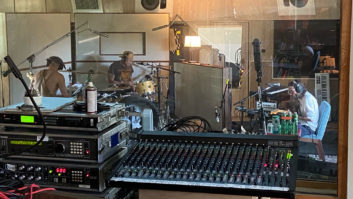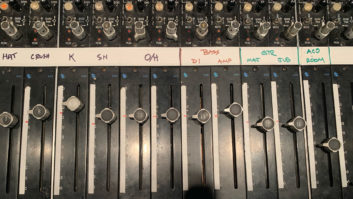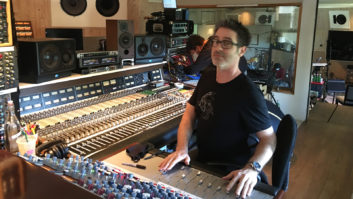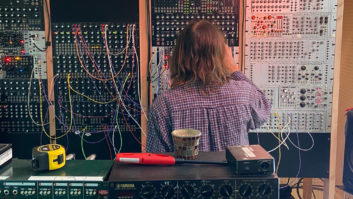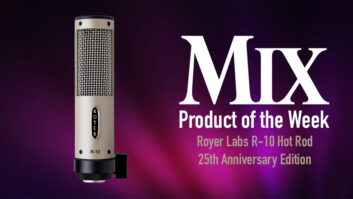Sitting in his living room sipping a glass of wine, the Red Hot Chili Peppers’ new album, Californication , blasting in the background, drummer Chad Smith can barely contain his excitement. He’s quite proud of the record, which marks the departure of guitarist Dave Navarro and the return of former axe-man John Frusciante. “There’s a definite chemistry that happens with the four of us, and it went so smooth,” Smith says. “When we’re able to just bang the songs out and we’re only concerned with trying to get good performances, it’s very easy. And when it goes easy, it’s fun and everybody is in a good mood.”
The band began their creative process in bassist Flea’s garage during the hot L.A. summer of ’98. The music grew out of sweaty jams within this very democratic unit. “If somebody’s playing something that one of us doesn’t like, we’re very honest,” Smith explains. “We’re lucky that we’re not afraid to say, ‘I don’t really like that,’ or, ‘That part sucks.’ And if the reply is, ‘But I really like it,’ you can still say, ‘No, man, I’m telling you, you don’t hear it.’ The worst thing, though, is if someone says ‘I don’t like it’ without being able to give a reason why. You always have to explain why. And if someone doesn’t like something, adamantly, even if everyone else does, there’s no reason to pour something down someone’s throat. It’s never going to work anyway if someone is not there. So we move on. We’ve got lots of ideas.
The only thing on this record like that was ‘Californication,'” Smith continues, “where Anthony [Kiedis, lead singer] really dug it and wanted to work on it, but we had wrestled with it and even hated it. Anthony had the words early on, and we had some music to it, but we struggled with the arrangement because it was kind of boring. No one was excited about it except Anthony. We were already into pre-production with Rick [Rubin] when John took the words home and came up with a simple guitar part for it. He brought it to the next rehearsal and it was completely different. He’s so good at that. He quit the band [years ago] and got into drugs really bad and hit bottom, but he’s come back to the band so focused. He’s been instrumental in the way this record sounds. And once he came in with a couple of new parts for ‘Californication,’ we were able to turn it into one of the best songs on the record.”
So if the music came together relatively easily, then why did this record take so long? Smith laughs as he explains: “It didn’t take long once we started writing it. We cut the basic tracks in seven days-23 tracks! Six years and seven days!” Six years had elapsed since the band had begun work on their last record, One Hot Minute. The delay was apparently due to personal problems that interfered with their productivity.
Although Smith has a bit of a wild-man reputation, drugs are not part of the picture. “The worst thing about drugs is that people get consumed by them and nothing else matters,” he says. “Things get done, but it takes a really long time. We recorded the tracks for One Hot Minute in ’94, and Anthony didn’t get around to singing on them until a year later, and that’s really frustrating. When you see how good things can really be, and you realize you could have three albums out in that [six-year period] and be cranking, it’s very frustrating. If we sucked and were playing bad music or we were just cranking it out because somebody gave us money to make an album, that would be a different story. But I think we’re a great band, and I don’t want to give up on it.”
The music playing in the background is proof of how good the Chili Peppers can sound when they focus their energy. This particular incarnation is the same that made the hugely successful Blood Sugar Sex Magik album. Although One Hot Minute was also acclaimed, it was highly influenced by Navarro’s more rock approach to music, whereas Californication is a return to more straight-up funk.
On Californication, the band worked with engineer Jim Scott. “If you tried to do something too tricky or too fancy or too much of your own thing [as the engineer],” Scott says, “it probably was not going to go the distance. To get it so they liked it, everything had to be loud and clear and you had to be able to hear everything they played, because it’s complicated. Flea plays very fast and very clear and has a great tone that he creates from his fingers on out, so it’s important to hear every note.” To complement that tone, Scott says the right equipment and location were necessary. They recorded in Ocean Way’s Studio 2 on the vintage Neve board, and Scott used a Neumann U47 tube mic on Flea’s bass amp. “It might have been a little bit of a strange choice, but it’s an exciting microphone that has a lot of character, and once you get it really working, the tubes will become an exciting part of the sound and create that energy he does,” Scott explains.
“My job was really easy,” he continues. “John and Flea make the sound with their hands. They don’t have to adjust things delicately to get the sound. They play it and it sounds right, so once you get a meat-and-potato sound on those guys that’s right, they adjust it. They just play the sound and we record it. There are only three guys playing music, and it makes a giant sound, so each guy is really filling up a lot of space. Just to get it the way they’re used to hearing it when they come in for a playback was the challenge. They sit real close to each other when they’re rehearsing and recording, so they know what they’re doing and what the other guy is doing musically.”
Although this was Scott’s first Chili Peppers project, he had worked with producer Rick Rubin on numerous other CDs, including Tom Petty’s Grammy-winning Wildflowers. Californication was Rubin’s third Chili Pepper production. “He’s the fifth member of the band,” Smith says of Rubin. “He’s not a technical guy at all-he’s not an engineer turned producer. He just knows what he likes. We’ll have ten song ideas, and we’ll play them for him at the point that we need an objective, unbiased opinion. Sometimes we butt heads, other times he’ll say, ‘I like that part, but that other part doesn’t do anything for me.’ Sometimes we don’t have lyrics and he’ll say, I like it, but I’ve got to hear it with the singing on it.’ He’s really good at melding our kind of unpolished musical sections into songs and helping us to get in and out of sections-out of verses into choruses. He might say, ‘A stop there would be nice,’ or, ‘You don’t need to do that fill, it’s too much, save that for the end.’ He’s there to pare it down and trim the fat. We’ll cut tracks and he might say, ‘That’s good, but that’ll be for the live version.’ If there’s too much playing, too much soloing, or it’s too busy or has too many fills, he’s the voice of reason. Not that it shouldn’t be exciting, but sometimes he feels it’s getting in the way of the overall picture, which is the song. He’s really good at that.”
Scott says as Rubin’s engineer, his first objective is to make him happy. “He and I have done enough records together that I know what he’s going for,” Scott says. “The records we’ve done are all loud and dry and clear: The drums are really loud, the vocals are really loud, and they’re focused on the groove and the song.”
“Loud and dry” is accomplished in part by not using any external ambience-creating devices. “I used tube compressors on the bass and solid-state compressors on the lead vocal and electric guitar, but it’s all the stuff you’ve seen a million times-LA-2As, 1176s, tools that have been my main crutches over the years. There’s no reverb, no echo, no delay, though,” Scott says, “none of the kind of stuff that sets things further back from where they physically are in the room. The second part of that is to keep the microphones really close to the source you’re trying to record. If I want the guitar to be really in my face, the microphones are as deep inside the speaker as I can get them-unreal-ly so. If the guitar player put his ear inside the speaker cabinet, he wouldn’t last too long. He’s usually standing six feet away from his amp going, ‘That sounds great-that’s my sound.’ But on a record, if you put the microphone six feet away from the guitar amplifier, it’s going to sound like it’s 20 feet away or 50 feet away. It’s not going to have the kind of power or impact that he’s used to feeling. He’s used to feeling it move his body and his clothes and blow air at him, and you can’t achieve that by putting the microphone in that spot. You have to get it closer and record that sound so it’s right there.”
Scott says his microphone choices are rather ordinary. “I’m a real simple man. The people I learned from made great rock ‘n’ roll records with the studio standard microphones. I hate to call them common or everyday, but I use Neumann and Sennheiser microphones-it’s the same stuff that’s available to everybody. I use the stuff that’s in every studio in town. This probably sounds very boring because everybody who is reading this is going to go, ‘That’s what I do, too.’ On the drums, I use Shure 57s on the snare drum, Neumann 47s on the kick drum and probably Sennheiser 421s on the toms. I put a microphone on all the drums, though,” he continues. “Some guys use maybe three or four microphones, which is sort of a Glyn Johns style, where you put two or three microphones on the whole drum set, and that’s your sound. That’s a classic sound, and it’s a beautiful sound, but it’s not necessarily an aggressive or tear-your-head-off sound.”
The track “Porcelain” required slightly different treatment. “We had a second kit that was tuned differently,” Scott explains. “There were different sized drums, and it had a different character. And Chad played it differently. It’s not a song he could slug out. He played it with a much finer touch, and for that we created a softer sound by moving the mics a little bit farther away. It was a much smaller kit, therefore fewer mics, and just the sound he made is the sound we recorded. It really sounds simple, but if you don’t do it right, then it’s wrong!
“And then there’s a certain amount of listening that goes into it,” Scott says. “As the engineer, you have to go out and listen to what they’re playing. If it doesn’t sound good when he’s playing it, it’s not going to sound good when you’re in there recording it. When the four Chili Pepper guys get together and play their music, they make the subtle adjustments. It really has very little to do with what microphone you put here or what EQ you put there. The best thing a recording engineer can do-especially at this level-is to not make any mistakes, not be part of the problem, and when everyone is getting nervous, not to be part of that.”
